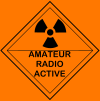Belgian Ham Exam
Belgian question pool by on1dht
DM7DS Amateurfunk & Hytera DMR Blog - VFO Codeplug for Hytera radios
DMR personal web site. Includes download links for Codeplug for Hytera AR685 PD685G, PD785G, PD785 & X1P with DMR Plus and Brandmeister support with VFO like channels. Repeater maps. In German.
W4JBM Jim
Information on ham radio including qrp, radio kits, Heathkit sw-717, Realisitic DX-160 and DX-302, and more.
North Jersey hamfest
Starting the season with us. Large indoor area plus tailgating
IOTA BASH 2020
The IOTA Bash, an annual event to raise funds for the "Island Radio Expedition Foundation" (IREF) [www.irefradio.com], is scheduled this year, March 27-28th, at AD5A’s QTH in Boerne, TX, near San Antonio, TX
South African Radio League Financial Statements
At the Council Meeting held on 7 and 8 February 2020, the SARL Council stated that an electronic vote (Rule 8.9.2) would be held
AO3MWC: Barcelona week instead of Mobile World Congress
22 February - 1 March this special event station will be on air thanks to Ràdio Club Barcelona, EA3RKB, echoing this first class international event hosted by the mobile world capital
SDR2020: the first French SDR Winter School
Don Beattie G3BJ reports more than 30 “SDR Geeks” attended the first SDR Winter School
Email addresses in Ireland
The Irish Radio Transmitters Society have issued an urgent reminder regarding email addresses following reports that holders of eircom.net email addresses will shortly incur a monthly charge for the use of their email address
AMSAT files comments opposing deletion of 3.4 GHz band
AMSAT has filed comments on the Federal Communications Commission's Notice of Proposed Rulemaking which proposes to delete the 3.3 - 3.5 GHz (9 cm) amateur band, including the 3.40 - 3.41 GHz amateur satellite service allocation
International all youth contesting team to compete in CQ WPX CW
Seven youth from 6 countries and 4 continents will meet this May at superstation K3LR in West Middlesex, PA and compete for 48 hours in CQ WPX CW in hopes to contend for a top finish, inspire more youth radio sport events, and ultimately bring down the average age of today’s contester
ARRL Website, Other Services to be Offline on February 28
The ARRL website and other online services will be offline on Friday, February 28, for up to 8 hours in order to conduct necessary maintenance. The outage will begin at 0500 UTC and should end by 1300 UTC. Affected will be the main ARRL website, the ARRL Store, and the ARRL contesting-related pages, including the log submission page. Logbook of The World (LoTW), email, and all ARRL Headquarters...
ARRL The American Radio Relay League
The American Radio Relay League (ARRL) web site
Pacemaker and Amateur Radio
An ARRL article collection about influence of radio frequency with pacemakers and other similar medical devices.
K4KSC The Titusville Amateur Radio Club
Brevard County, Florida, USA
Sunraysia radio group
Guohe Electronics
Manufacturers/Software Defined Radio
Chinese manufacturer of Software Defined Radio for commercial, public and amateur radio market. Markers of H1 H1Plus H2 Q900 SDR transceivers
ICOM Tuner Connector
Antennas/Tuners
Many Icom radios e.g.7100 have a connector for automatic tuners such as the Icom AH4. The cable supplied by Icom is of a fixed length 10m and is not shielded. Icom recommends to use shielded cable for any length greater than 10m.
40 meter portable dipole for QRP operations
Antennas/Dipole
Schematic drawing and instructions for the construction of a simple portable dipole for use in low power and portable operations
Top Amateur Radio Websites - Issue 2004
Experimental HF 6-band SSB transceiver, The half-wave dipole, your first antenna, A Three-Band One-Tube Novice Transmitter, The Spectrum Monitor, Optocoupled Transceiver-PC Audio Isolator project, TI9A Isla del Coco Chatham Bay DX-pedition, V31YN
Q900 SDR Transceiver
Q900 portable Amateur radio transceiver for the HF, VHF & UHF bands working AM FM SSB CW RTTY by Guohe Electronics.
Arfon Repeater Group
Arfon repeater group serving radio amateurs in north west wales or over 30 years
BDM Club
Club Belgium Digital Mode application for smartphone android is on line
RADIOAMATORO blog en ESPERANTO
An original amateur radio blog in Esperanto lenguage, all about ham radio, DX, antenna.
Make your own 2 metre 5/8 whip antenna
Antennas/2M
This article is about a home made project of a whip antenna for 2 meters band. Includes lenght of whip for all frequencies from 140 MHz to 151 MHz both in mm and inches
CQ WW 160 m SSB Contest 2020
The CW mode is held the final full weekend of January. The Phone mode is held the final full weekend of February.
Down Under Amateur Radio Special Event
Over the March 14 – 15 weekend, members of the Shepparton and District Amateur Radio Club (SADARC) in Australia will be on the air as VI3RA (Radio Australia), connecting their transceivers to the curtain array and rhombic antennas at the former Radio Australia site in Shepparton. Radio Australia ceased transmitting from the site in 2017
Low Cost HF Portable Antennas
In this Waters and Stanton video Peter Waters G3OJV looks at simple low-cost HF portable antennas
State law protects ham radio operator
The York Dispatch reports on the case of radio amateur Lindsey Fowler K0WXT who installed a short mast at her home
Distracted Driving in Canada update
Distracted driving regulations continue to be an area of interest for many Canadian Radio Amateurs. These regulations are made and enforced by provincial governments and can vary considerably from province to province and over time
Ofcom consultation on EMF compliance
Ofcom is holding a public consultation on proposed measures to require compliance with international guidelines for limiting exposure to electromagnetic fields (EMF)
ARRL Audio News - February 21, 2020
ARRL Audio News - February 21, 2020
Mississippi ARES® Emergency Coordinator Credits Training for Effective Tornado Response
Amateur Radio Emergency Service® (ARES®) volunteers in DeSoto County, Mississippi, devoted several days in January to assisting local emergency managers in responding to tornado damage in the region. Desoto County Emergency Coordinator Ricky Chambers, KF5WVJ; Assistant EC Gene Adams, KF5KVL; Tate County EC Brad Kerley, KG5TTU, and Andy Luscomb, AG5FG, reported at 3 AM on January 11 to the DeSot...
New World Distance Record Claimed on 122 GHz
A new world distance record of 139 kilometers (86.2 miles) is being claimed by radio amateurs in northern California. This tops the record of 114 kilometers set in 2005 by WA1ZMS and W4WWQ, according to the Distance Records on the ARRL website. The February 17, 2020, contact was between Mike Lavelle, K6ML, on Mount Vaca (CM88WJ75ON) at 835 meters (2,739.5 feet) above sea level, and Oliver Barret...
France Authorizes Use of 60-Meter Band
|









